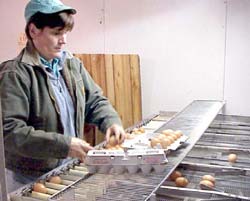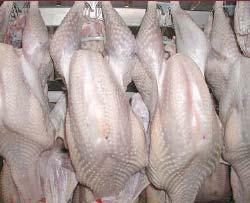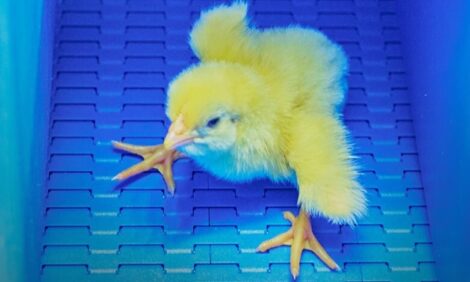



Organic Poultry Production in the US: Transport and Processing
Organic Poultry Production in the United States was published by ATTRA in 2008. It discusses organic husbandry including living conditions, health, genetics and origin, feed and processing as specified under the livestock requirements of the US Department of Agriculture National Organic Program (NOP). This article covers issues regarding transport and processing, including a comparison of NOP standards with those in other countries.
(Photo: Rex Dufour, NCAT)
Slow-growing turkeys cooling in air-chilled room (below)
(Photo: Anne Fanatico, NCAT)

If meat or eggs are processed on-farm, the processing must comply with the organic handling standards. This information appears in sections 205.270 to 205.272 of the NOP Final Rule. If the meat or eggs are handled off-farm, the processing plant must be certified organic.
Processing plants that are that already complying with federal or state regulations are usually not difficult to certify as organic. Important points include using approved organic detergents and sanitisers and pest control methods, preventing contamination and preventing commingling with non-organic products. Good record-keeping is important for the audit trail. Organic is usually the first run of the day if plants also processes non-organic products. Operations that compost offal and apply it to organic fields or pastures should follow NOP requirements for compost and manure management.
Sanitisers that may be used in organic poultry meat processing facilities to sanitise facilities and equipment are more limited than in conventional operations and include chlorine materials, hydrogen peroxide, peracetic acid, phosphoric acid and organic acids. (See the brand name lists on the Organic Materials Review Institute's web site for products that are permitted.
Some certifiers permit highly chlorinated water to come in contact with food products in immersion chilling and for sanitising surfaces but the final rinse should be with a chlorine level less than the limit under the Safe Drinking Water Act (or 4 ppm).
For chill tank water, some organic poultry processors use no additives at all in the chill tank; others use hydrogen peroxide or innovative technologies such as ozonated water. Post-chill antimicrobial dip and spray are of interest. Shell egg detergents and sanitisers should also be NOP-compliant.
| Table 1. Comparison of highlights of poultry requirements regarding transport and processing of selected organic programmes | ||||||
|---|---|---|---|---|---|---|
| USDA NOP | European Union | Soil Association (UK) | Canada | National Bio-Gro (New Zealand) | IFOAM 2002 | |
| Transport / processing | Should be low stress | Humanely kill unfit birds and protect birds from elements during loading, unloading and lairage | Should be low stress; humanely kill unfit birds | Detailed transport standards | Transit time must not exceed 8 hours; transport & slaughter should minimize stress and adverse effects of temperature | |
March 2009








